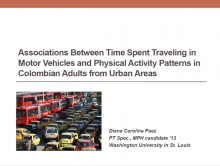We are pleased to announce an exciting new alliance between Active Living Research and GP RED to co-host and coordinate...
Associations Between Time Spent Traveling in Motor Vehicles and Physical Activity Patterns in Colombian Adults Living in Urban Areas

Presentation at the 2013 Active Living Research Annual Conference.
Background and Purpose
Sedentary Patterns (SPs) are associated with potentially adverse health consequences. Furthermore, physical inactivity (PI) currently represents the fourth highest risk factor for mortality and caused about 5.3 million of the 57 million deaths from chronic diseases worldwide in 2008. In addition, recent evidence suggests that, independent of Physical Activity (PA) levels, SPs are associated with increased risk of cardio-metabolic disease, mortality, and a variety of physiological and psychological problems. Among SPs, Time Spent Traveling in Motor Vehicles (TSTMV) may have public health relevance due to its links with environmental urban attributes and its potential influence on PA patterns at the population level. Preliminary evidence has shown an inverse relationship between PA and TSTMV. In Colombia only 63.5% of men and 46.1% of women meet the PA recommendations for health as a means of transportation and leisure time, and the percentage of car sales is increasing with time. However, the link between TSTMV and PA patterns has not been sufficiently studied in the complex urban context of Latin American countries.
Objectives
Therefore, the aim of this study is to assess the associations between TSTMV and the following patterns of PA: walking and bicycling for transport and leisure time PA among Colombian adults.
Methods
This is a study based on secondary data analysis of the 2010 National Nutrition Survey of Colombia (ENSIN), which included information from 7,313 Colombian adults aged 18 to 64 years from urban areas with more than 82,000 inhabitants. The PA levels and TSTMV were measured using the adapted Spanish version of IPAQ, using the domains of leisure time and transportation (walking and bicycling). The association between the TSTMV and the PA domains was assessed using binary logistic regression. Multicollinearity was assessed using tolerance tests and no significant results were found. These models were stratified by selected socio-demographic characteristics and adjusted for potential confounders.
Results
The mean age for the total population sample was 37 years. The population was predominantly female (58.5%); the majority of respondents were in the 30–49 years category (44.8%), the incomplete secondary education level (47.4%), and in the 82,000 to 288,000 inhabitants category (35.4%). Having worked was reported by 61.9% of the participants and 45.7% constituted the middle upper Socio Economic Position (SEP). Concerning the prevalence of TSTMV by selected characteristics, it was found that males (34.0%), participants in the highest education level (31.1%), upper middle SEP (25.0%) and working occupation category (31.4%) had the highest prevalence of TSTMV, spending 120 minutes or more in motor vehicles per day. The results regarding the prevalence of transport-related PA domains by selected characteristics shows that males (38.0%), participants in the lowest urbanization levels (41.2%), searching for a job (40.1%) and those who spent zero minutes in TSMV a day (42.1%) were more likely to walk 150 minutes a week as a mean of transport. In addition, males (9.1%) and participants with lower education level (5.4%) were more likely to use bicycles as mean of transport. For the leisure time PA domain, males (26.4%), the youngest age group (23.2%), and the highest education level (21.8%) showed a significantly higher prevalence of leisure time PA. In the adjusted models it was found that those who reported zero minutes of TSTMV were more likely to walk and bike as a means of transport. No significant association was found in leisure time PA. A consistent negative dose response was found between TSTMV and biking for transportation (p trend <0.001). After stratification, it was found that occupation is an effect modifier of the association TSTMV and PA domains.
Conclusions
In this study we found a negative association between TSTMV and PA levels among Colombian adults living in urban areas. Due to the challenges of urban development and the increases in car ownerships in Colombia, it is important to highlight the need of public policy actions such as an integrated transportation system and/or better urban design strategies that promote active versus motorized transportation and reduce TSTMV to positively impact on the PA levels of the population.
- DOWNLOAD "2013_BEAdults_CarolinaPaez.pdf" PDF (0.18 MB) Presentations
STAY UP TO DATE
RECENTLY ADDED TOOLS & RESOURCES
MOVE! A BLOG ABOUT ACTIVE LIVING
The "Active Living Conference" aims to break down research and practice silos and...







